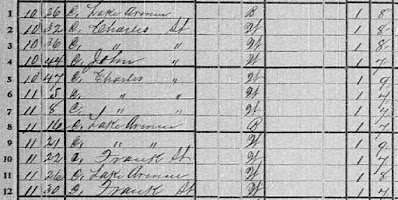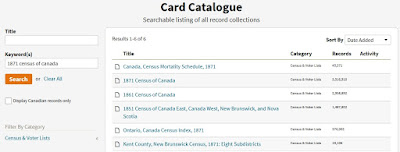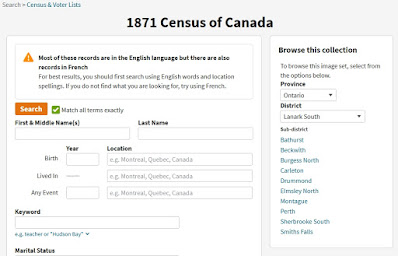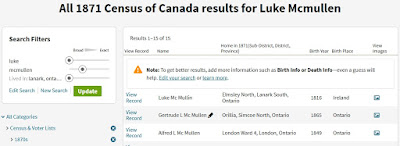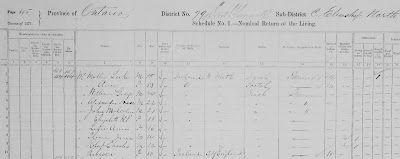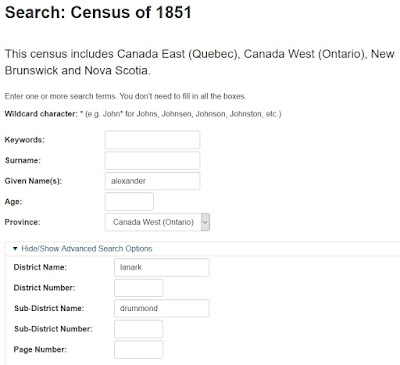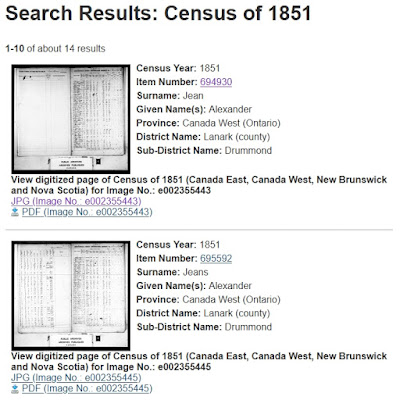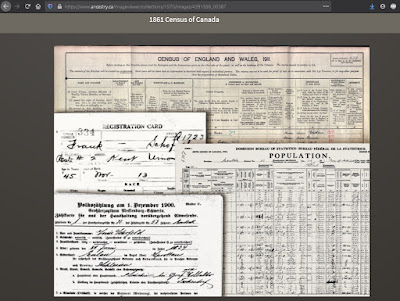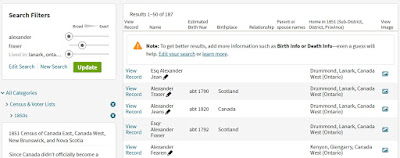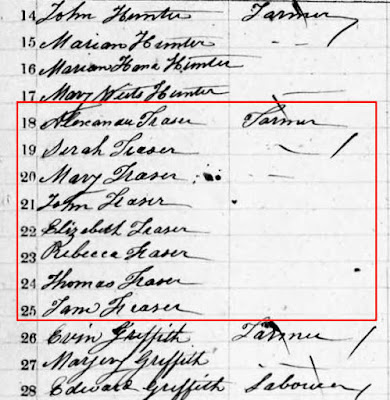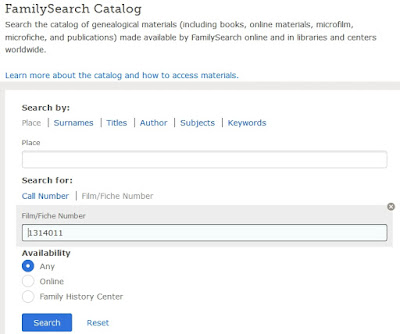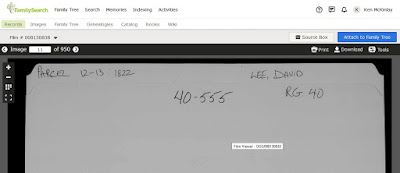- Census of 1851 - Canada West: Searching with Ancestry or Library and Archives Canada
- Census of 1861 - Canada West: Searching and a caveat
- 1871 Census of Canada - Ontario: Searching
Unfortunately for us, only the "Nominal return of the living" or "Population" schedules for the 1881 and 1891 Censuses of Canada have been preserved. So we are out of luck with using them. However, we are in luck with the 1901 Census of Canada since both the Populations schedule, which we so often use, and the "Buildings and lands, churches and schools" schedule has been "entirely" preserved.
So off we go into delving into the 1901 Census of Canada looking for the concession and lot of one of my relatives who lived in rural Ontario. We will be using my 3rd great-grandfather, Luke McMullen, born about 1819 in Ireland as our subject. In earlier census enumerations he could be found in Lanark County, Ontario, Canada.
Much like the 1871 census of Canada where we first have to find them in the population schedule, we need to do the same for the 1901 census.
We are going to start on the Library and Archives Canada site's Census of Canada, 1901 page.
 |
| Screen capture of the Library and Archives Canada Census of Canada, 1901 page. |
While we are here, take some time to look around the page. There are links to details concerning the instructions to enumerators, other places on the Internet where indexes to this census can be found (including but not limited to Ancestry, FamilySearch, Findmypast, MyHeritage, and Automated Genealogy), and which sub-districts may not have survived. One thing to note is that what has survived was initially microfilmed in the mid 1950s and the original paper records were destroyed.
 |
| Screen capture of the Library and Archives Canada Census of Canada, 1901 search page searching for Luke McMullen in Ontario. |
Above is the search page from Library and Archives Canada for the 1901 Census of Canada with the details for Luke McMullen filled in. Keep in mind, that unlike the search system found on Ancestry or FamilySearch, the Library and Archives Canada search system doesn't make use of "sound like" or approximations in their search. If you can't initially find the person in the census, play around with the spelling of the name and also use the "*" wildcard in the search, possibly like "mcmul*" for "McMullen" and variants.
Only one result was returned and we can see a clipping from the image of the census page above. There we see on line 47 Luke McMullen is found in dwelling 17, household 17, that of Louis Darou, recorded as the father-in-law. Lydia A, the wife of Louis, was one of Luke's daughters.
The following details are needed to find the household entry in Schedule 2, "Buildings and lands, churches and schools":
- District: 81 (South Lanark)
- Sub-district: F
- Division: 2
- Page: 2
- Line: 42
Why line 42 and not line 47 where Luke is listed? Schedule 2 points to the head of the household within the Population schedule. So we need to record the line number for Louis Darou.
Now we need to go to the Schedule section of the Census of Canada, 1901 page on the Library and Archives Canada site. There we will find more information about Schedule 2 including links to a number of PDFs that will aid us in finding the digitized images of Schedule 2.
- British Columbia [PDF 1.08 MB]
- Manitoba [PDF 1.72 MB]
- New Brunswick [PDF 1.77 MB]
- Nova Scotia [PDF 2.25 MB]
- Ontario [PDF 12.4 MB]
- Prince Edward Island [PDF 720 KB]
- Quebec [PDF 8.60 MB]
- Yukon Territory and North-West Territories, and the District of Keewatin [PDF 1.10 MB]
For this example we need to open up the PDF for Ontario. Within we find the links to the images of Schedule 2. The order in the PDF is by district, sub-district, division, and then page number.
We can have the computer search for the name of the sub-district, if known, but often scrolling through the index, even one of 381 pages like that for Ontario, is just as quick. Here we find the various entries for Lanark South (81), Elmsley North (F) at the bottom of the page. There are two divisions for that sub-district so we want to pick the correct one. In our case it is division 2.
A gotcha then appears...the page numbers don't refer to the page numbers from Schedule 1, Population, but to the page numbers for Schedule 2. So for Elmsley North, Division 2 there are 2 pages we might need to look at. Other sub-districts may have many more pages in Schedule 2 like we see for the town of Carleton Place.
We are going to click on the image link for page 1 of Schedule 2 for Lanark South, Elmsley North, Division 2 to see if we can find the entry for Louis Darou.
Scanning down the first two columns of that page we can quickly find an entry for page 2, line 42 from the Population schedule on line 18. There the place of habitation is recorded as:
b. con. 10 pt. lot 27
So it would appear that Louis Darou and, also by being in the same household, Luke McMullen reside on part of lot 27 on the 10th Concession of the Township North Elmley in Lanark County, Ontario, Canada. We can now use OnLand or the land records on FamilySearch to find out more about the history of the ownership of that property. Maybe we can look up that location on a map and have a road trip.
But what is that "b"?
At the top of the page in the column headings it describes the code to use for the place of habitation:
- a. Name of Municipality, Township, or Parish.
- b. Range or concession and lot, or cadastral number.
- c. Street and house number.
- d. Or other description.
The enumerator is informing us that this is a "Range or concession and lot, or cadastral number."
How about a location within a town?
Here we can see the clipping for Carleton Place. In this case the street name is given but not the house number.
The same information can generally be found on Ancestry in the 1901 Census of Canada pages. However, due to the way the images were originally microfilmed, the Schedule 2 images are often found before the Population schedule pages for the sub-district and division. Instead of flipping forward to the Schedule 2 images you actually need to go backwards through the images and keep going past the start of the Population schedule for that location. Then, hopefully, you will find the schedule for "Buildings and lands, churches and schools" for the place of interest. Make sure you pay attention to the top of the pages to make sure you are looking at the right place.
Regrettably, much like the 1881 and 1891 Censuses of Canada, only the Population schedule for the 1911 and 1921 censuses was preserved.
I sincerely hope that this series of posts about using the agricultural or other schedules has helped you find your ancestors on the ground in Ontario/Canada West.
 In several of my previous posts we've looked at the various censuses taken in Ontario, or what would later become Ontario, to figure out where our rural ancestors resided:
In several of my previous posts we've looked at the various censuses taken in Ontario, or what would later become Ontario, to figure out where our rural ancestors resided:


